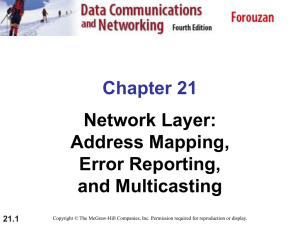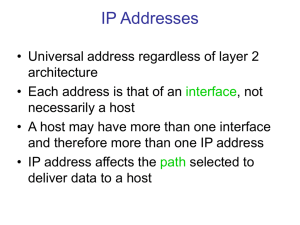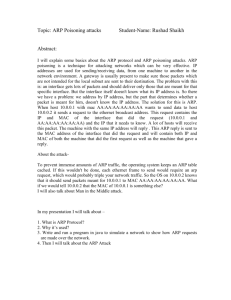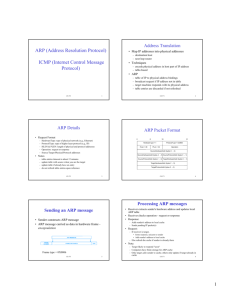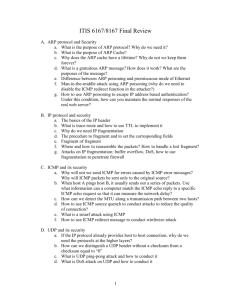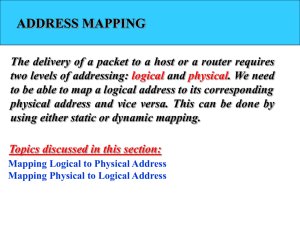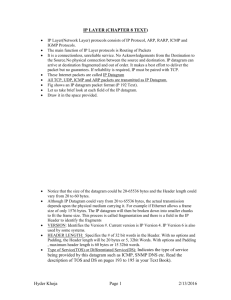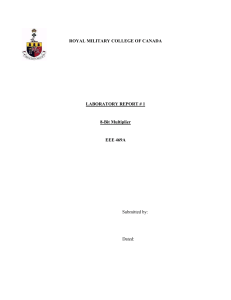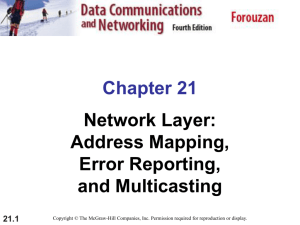View File - UET Taxila
advertisement
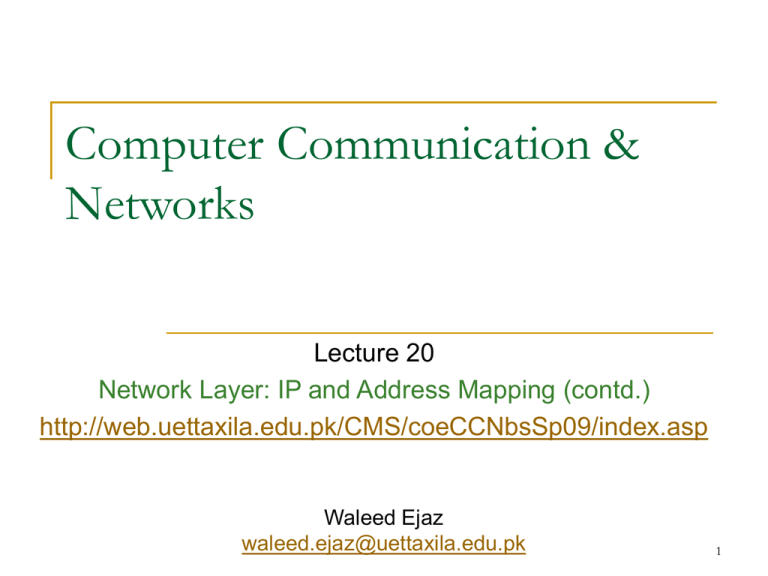
Computer Communication & Networks Lecture 20 Network Layer: IP and Address Mapping (contd.) http://web.uettaxila.edu.pk/CMS/coeCCNbsSp09/index.asp Waleed Ejaz waleed.ejaz@uettaxila.edu.pk 1 Address Mapping 2 Address Mapping The delivery of a packet to a host or a router requires two levels of addressing: logical and physical. We need to be able to map a logical address to its corresponding physical address and vice versa. This can be done by using either static or dynamic mapping. 3 ARP and RARP 4 ARP - The Address Resolution Protocol An IP datagram must be encapsulated in a frame to pass through the physical network. This requires the physical address of the receiver. ARP associates an IP address with its physical address. When the physical address of another host is required an ARP query packet is sent which includes IP address of sender IP address of the receiver The intended recipient recognises its IP address and send back an ARP response which contains the physical address. 5 ARP operation 6 ARP Request & Reply 7 Proxy ARP 8 ARP functions Sender knows IP address IP asks ARP to create an ARP request message sender physical address sender IP address target IP address target physical address filled with 0's Message passed to data link layer; destination address = broadcast address All hosts receive frame; only target host accepts the packet Target host replies (unicast) with an ARP reply message containing the physical address Sender receives reply; it now knows the physical address of the target host IP datagram's are now unicast to the destination host 9 Cache Table A sender usually has more than one IP datagram to send to the same destination It is inefficient to use ARP for each datagram A cache table is used limited size mappings retained only for a limited time 10 RARP Finds the logical address for a host that only knows its physical address RARP request packets are broadcast; RARP reply packets are unicast Used by diskless machines to obtain their IP addresses 11 Operation 12 Note An ARP request is broadcast; an ARP reply is unicast. 13 ICMP 14 ICMP protocol IP protocol is a best-effort delivery service, however it has two deficiencies Lack of error control Lack of assistance mechanisms IP protocol has no error-reporting or error-correction mechanism What happens when something goes wrong? What happens if a router must discard a datagram because it cannot find a route to the final destination? What if the time-to-live field has a zero value? What if it has to discard all fragments because not all were received in a predetermined time limit? IP protocol also lacks a mechanism for host and management queries. ICMP was designed to compensate for these deficiencies. 15 Internet Control Message Protocol (ICMP) ICMP is used by routers for exchanging error information and for testing. The principal ICMP message types are shown below. 16 Internet Control Message Protocol (ICMP) Encapsulated in IP packet Handles error and control messages If router cannot deliver or forward a packet, it sends an ICMP “host unreachable” message to the source If router receives packet that should have been sent to another router, it sends an ICMP “redirect” message to the sender; Sender modifies its routing table ICMP “router discovery” messages allow host to learn about routers in its network and to initialize and update its routing tables ICMP echo request and reply facilitate diagnostic and used in “ping” 17 Example – Echo request 18 Example – Echo Reply 19 General format of ICMP messages 20 Note ICMP always reports error messages to the original source. 21 Quiz 4 Assuming class full addressing, what is the default subnet mask for the IP address 126.0.0.0: [1] Assuming classless IP addressing, what is the subnet mask for the IP address 126.0.0.0/23: [1] Consider the IP address 200.10.10.10/25. What is the maximum number of interfaces (hosts) supported by the network, of which this IP address is a part? [1] An organization is granted the block of IP addresses: 130.34.12.64/26. The organization needs to have four subnets of equal size, i.e. with equal number of hosts. Provide the range of IP addresses (of the form a.b.c.d/x) for each subnet. Explain your work! [8] 22


